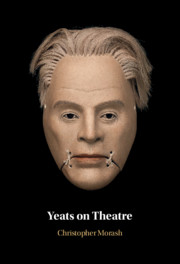Book contents
- Yeats on Theatre
- Yeats on Theatre
- Copyright page
- Contents
- Acknowledgements
- Abbreviations
- Introduction The Exact Moment
- Chapter 1 The Playwright as Thinker
- Chapter 2 The Fugitive Organum
- Chapter 3 Tragedy and Comedy
- Chapter 4 Form
- Chapter 5 Spaces and Objects
- Chapter 6 Bodies and Voices
- Chapter 7 Audiences
- Conclusion A Moment of Intense Life
- Notes
- Bibliography
- Index
Chapter 5 - Spaces and Objects
Published online by Cambridge University Press: 09 July 2021
- Yeats on Theatre
- Yeats on Theatre
- Copyright page
- Contents
- Acknowledgements
- Abbreviations
- Introduction The Exact Moment
- Chapter 1 The Playwright as Thinker
- Chapter 2 The Fugitive Organum
- Chapter 3 Tragedy and Comedy
- Chapter 4 Form
- Chapter 5 Spaces and Objects
- Chapter 6 Bodies and Voices
- Chapter 7 Audiences
- Conclusion A Moment of Intense Life
- Notes
- Bibliography
- Index
Summary
Although he is usually thought of as a poet who wrote for the theatre, W. B. Yeats was a theatre practitioner for almost fifty years, and was closely involved in every aspect of producing his plays.As a consummate theorist of the theatre, he thus produced theories relating to theatre space, the use of colour, and an understanding of the uncanny power of objects that prefigures later phenomenological thinking on the same subject.He formulates these precepts early in the 1900s, laying down principles for the use of colour, for instance (two main colours and an accent only), but by the time of his more mature work, he is using objects – such as the severed heads that appear in his later plays – in a way that develops his own thinking on the relation between thought and matter.Indeed, a consideration of Yeats’s understanding of the physical elements of performance shows him to be someone who thinks through the medium of theatre, to borrow a concept from Alain Badiou; using the nature of performance as a means of thought.
Keywords
- Type
- Chapter
- Information
- Yeats on Theatre , pp. 113 - 142Publisher: Cambridge University PressPrint publication year: 2021

